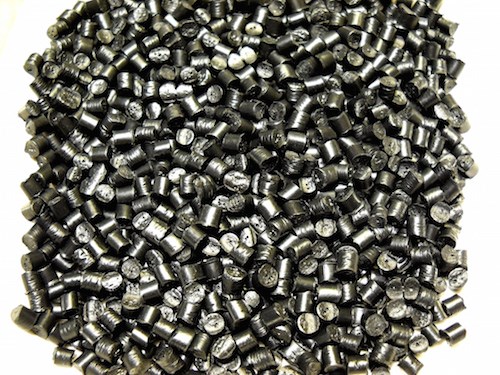The 5 M’s of Molding—Part 3: Material
You’ve accounted for variability in two other “Ms”—mold and man—but materials in their lot-to-lot differences and handling challenges pose a distinct threat to repeatability.
You’ve accounted for variability in two other “Ms”—mold and man—but materials in their lot-to-lot differences and handling challenges pose a distinct threat to repeatability.
Material: One of the fundamental considerations in processing is the material being used. Processing relies heavily upon the consistency and quality of the plastic that has been chosen for the part’s aesthetic and dimensional make up. Here are some of the primary variables that need to be reviewed during the stages of process development and in some cases continuous improvement.
Properties: Every material has its own unique set of molding properties that must be considered as a molding operation is developed. Here is a list of some of these properties as they relate to part aesthetics and dimensions:
Temperature- Mold and barrel temperatures are a huge part of the molding equation. Some examples of potential heat-related deficiencies would be long cycles, warping, burn at end of fill, gassing, etc.
Shrinkage- Every material has its own rate of shrinkage and this is one key measurable that should be considered as material choice is being decided.
Melt Flow: Material viscosity is a key component during process development and improvement review. For instance, a heavily ribbed part might be better suited with a material with a low viscosity to assure that the flowfront moves quickly across the ribs preventing an overpack condition.
Aesthetics & Dimension: There are many variations on engineered materials that either benefit or detract from the overall performance and functionality of part production. Utilize the knowledge and resources of your material manufacturer whenever possible to find the appropriate material solutions.
Additives: There are many situations where material additives can create problems or provide solutions. For instance, the use of color mixing may seem cost effective, yet generate scrap due to poor diffusion leading to faulty parts via color swirls. Or from a different perspective, adding a lubricant to polypropylene might eliminate parts sticking in a mold where draft cannot be added. Work with your material supplier to develop and/or improve a part’s molding capabilities.
Drying: Drying is always a major factor in process consistency. Verify that your dryer throughput is sufficient enough to allow adequate time to properly dry the material being used. It is also important to verify that the material is truly dry through moisture analysis.
Characteristics: When choosing a material, it is important to understand what the typical characteristics are regarding a material’s performance and drawbacks. For instance, nylon has a tendency to shrink; polypropylene tends to have sink issues over large or deep ribs. Look for materials that match the functionality of the part being molded while avoiding potential problems associated with material choice.
Garrett MacKenzie is the owner and editor of . Mackenzie started in plastics at the age of 19 as an operator, eventually moving up through the ranks to engineering and management over a 29-year timeframe. He currently works as a plastic injection consultant in engineering and training capacities. He can be contacted at garrett.mackenzie@mail.com.
Next week, Part 4 in The Five “Ms” of Molding: The Machine

Related Content
Absolute Haitian Brings Next Generation of Presses to Orlando
NPE2024: Absolute Haitian says Generation 5 of the servo-hydraulic Haitian and electric Zhafir machines lines emphasize efficiency, performance and intelligence.
Read MoreLS Mtron’s Outsized NPE2024 Presence Jump-Starts Ambitious North American Market Goals
The Korean maker of injection molding machines featured eight machines in its nearly 14,000-square-foot booth with additional presses at Yushin and Incoe’s booths, as it targets 20% market share.
Read MoreU.S. Debut for Slimmed Down Electric Machine
NPE2024: Arburg’s debut of the 310-ton Allrounder 720 E Golden Electric extends the tonnage range of the electric series and marks the first global press premiere outside of Germany.
Read MoreDigital Manufacturing: Two Medical Molders Embrace Industry 4.0
‘Digitalization’ and ‘connectivity’ are loaded terms—shorthand for a whole new way of doing ´óĎó´«Ă˝. It can’t be accomplished in one go. But two Midwest molders in the sensitive medical field are already feeling the benefits of their initial steps in that direction.
Read MoreRead Next
Beyond Prototypes: 8 Ways the Plastics Industry Is Using 3D Printing
Plastics processors are finding applications for 3D printing around the plant and across the supply chain. Here are 8 examples to look for at NPE2024.
Read MoreFor PLASTICS' CEO Seaholm, NPE to Shine Light on Sustainability Successes
With advocacy, communication and sustainability as three main pillars, Seaholm leads a trade association to NPE that ‘is more active today than we have ever been.’
Read MorePeople 4.0 – How to Get Buy-In from Your Staff for Industry 4.0 Systems
Implementing a production monitoring system as the foundation of a ‘smart factory’ is about integrating people with new technology as much as it is about integrating machines and computers. Here are tips from a company that has gone through the process.
Read More












